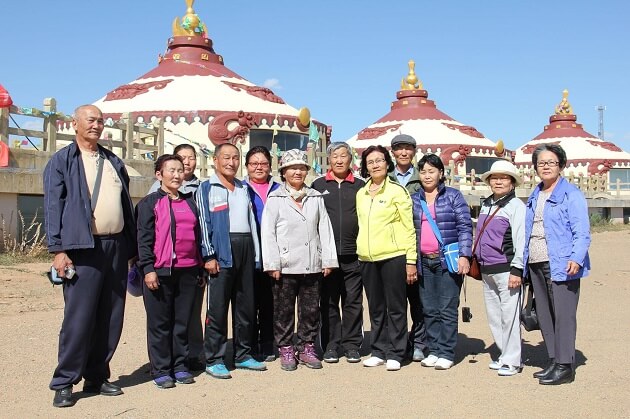 My name is Sarang Badeev. 25 years ago, I came to faith in Christ in Kalmykia. For 15 years, I pastored the church which had been planted in the capital city, Elista, in the early 1990ties. For the last ten years, I have been traveling and preaching the Gospel to Kalmyks who live in other countries, especially in China, Mongolia, and the United States. The following is a travel letter from my last visit to Kalmyks living in Central Asia and China.
My name is Sarang Badeev. 25 years ago, I came to faith in Christ in Kalmykia. For 15 years, I pastored the church which had been planted in the capital city, Elista, in the early 1990ties. For the last ten years, I have been traveling and preaching the Gospel to Kalmyks who live in other countries, especially in China, Mongolia, and the United States. The following is a travel letter from my last visit to Kalmyks living in Central Asia and China.
The Mongol-speaking Kalmyks are Western Mongols. Their language is different from that of other Mongols, so some linguists think that theirs is an archaic and ancient Mongolian language. Following after the Huns, Avars, and other ethnic groups, Kalmyks are the last nomadic people who crossed the steppes of Asia and reached Europe, where they settled. They are also the only people who later managed to migrate back to Asia from where they came, although half of them remained in Russia, where they today live in the Russian Autonomous Republic of Kalmykia, located between the Black and Caspian Seas.
Kalmyks are monotheists (believing there is only one God). That comes from the fact that in the past, the Kalmyks were Christians, evangelized in the 7th century by Nestorian missionaries who were sent out by the East Assyrian Church. This makes it, to some extent, easier to preach the Gospel among them. For example, in Kalmykia Russia, they are monotheists in mindset, therefore easily understand the doctrine of God’s Majesty, his Power, and his Unity.
In China, Kalmyks remember well that, in the past, they had been Christians. Several have told me, “When we were Christians, we were strong.” This makes a bridge between them and me when I preach. 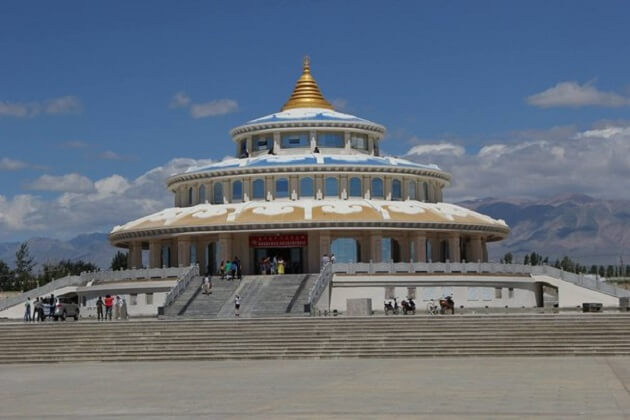 Centuries later, while the Kalmyks in China were under the rule of the Qing Dynasty, they were introduced to and embraced Buddhism. Presently, Buddhism plays a big role in their lives. In their Buddhist temples, they have their own ethnic priests. Despite the fact that the majority of Kalmyks in China lead a nomadic lifestyle, they make a point of visiting these temples, which are their religious centers. In Russia, the Kalmyks are not Buddhists in lifestyle; nevertheless, the religion is deeply ingrained in their minds. It is more their identity marker – who they think they are.
Centuries later, while the Kalmyks in China were under the rule of the Qing Dynasty, they were introduced to and embraced Buddhism. Presently, Buddhism plays a big role in their lives. In their Buddhist temples, they have their own ethnic priests. Despite the fact that the majority of Kalmyks in China lead a nomadic lifestyle, they make a point of visiting these temples, which are their religious centers. In Russia, the Kalmyks are not Buddhists in lifestyle; nevertheless, the religion is deeply ingrained in their minds. It is more their identity marker – who they think they are.
They accept and respond to the Gospel and agree with everything the Scripture states, but they fear they will lose their ethnic identity if they abandon Buddhism. Repentance and conversion to Christ could have been massive if it weren’t for this fundamental fear, since they are more monotheistic in their mindset and drawn to the Gospel. I believe and know that God will break this barrier.
Sociological research has shown that the Eastern Mongols identify with the East. i.e. Japan and Korea; the Kalmyks identify themselves as Western, as they live closer to Western values — having a more open mind, being not as easily blinded by their culture, they are more quickly transformed by the influence of the Gospel.
MY VISIT TO CHINA
included three autonomous districts inhabited by the Kalmyks: Xinjiang Uygur Autonomous Region, Inner Mongolia and the Qinghai province. For several years, I have been traveling to the Xinjiang province, where I pastor a church of 38 Kalmyk nomadic believers who live and move within a large area.
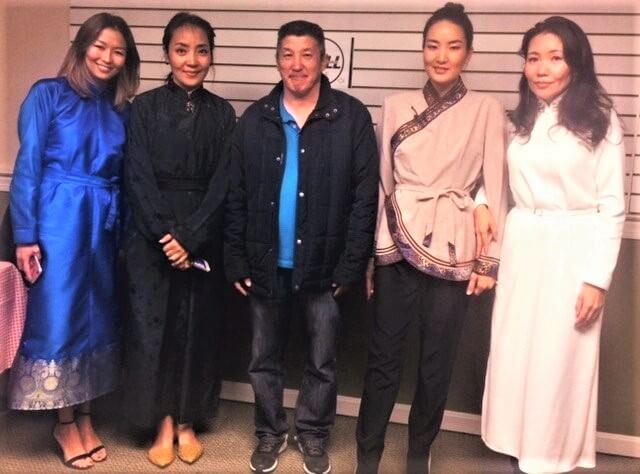 Missionary work is most often focused on evangelizing people in the cities, but the countryside is often overlooked. Since the people I minister to are nomads who roam with their herd across the foothills and high mountains of this province, constantly looking for new pastures, I move with them to these places. They are rarely stationed in the same place for very long. These are the people I am primarily seeking to reach with the Gospel. It is a difficult endeavor, as it is necessary to cover long distances, sometimes going to hard-to-reach places.
Missionary work is most often focused on evangelizing people in the cities, but the countryside is often overlooked. Since the people I minister to are nomads who roam with their herd across the foothills and high mountains of this province, constantly looking for new pastures, I move with them to these places. They are rarely stationed in the same place for very long. These are the people I am primarily seeking to reach with the Gospel. It is a difficult endeavor, as it is necessary to cover long distances, sometimes going to hard-to-reach places.
I was told about a man, 80 years old, who was a hunter and lived by himself, isolated from other people. In order to find him and give him the Word of God, I employed a local guide. We traveled first by car, then on horseback, and then we climbed on foot up steep hillsides, high up into the mountains, where he lived. He was a wonderful man. Despite his age, he had single-handed taken on a bear with just a knife. I shared the Gospel with him. He told me that we Kalmyks used to be Christians, and that we had our own Bible, and our own church called the House of Worship – and that Buddhism is not ours, it is Tibetan with Tibetan words and names. He wanted to receive Jesus Christ into his heart. I asked him if he really wanted to accept Jesus. He said Yes, so we prayed, and by faith, and he accepted the Lord!
 I have translated some of the books of the New Testament into the Kalmyk language. The senior generation of Kalmyks in China speaks the Kalmyk language verbally, while young people both speak it and prefer to read Christian literature in the language. The Old Testament and many of the books of the New Testament are not yet translated. When I am not traveling, or have time in between trips, I focus on the translation work, but it is a slow process that I wish would go faster.
I have translated some of the books of the New Testament into the Kalmyk language. The senior generation of Kalmyks in China speaks the Kalmyk language verbally, while young people both speak it and prefer to read Christian literature in the language. The Old Testament and many of the books of the New Testament are not yet translated. When I am not traveling, or have time in between trips, I focus on the translation work, but it is a slow process that I wish would go faster.
When I left Xinjiang, I placed one of the believers in charge of the church. He was arrested by the police and kept in prison for a time, but was later released. The Christians are growing in faith and knowledge.
IN INNER MONGOLIA
the Kalmyks live in an area called Alashan. Basically, it is a nomadic community where families live and wander in desert and semi-desert regions, and in vast nature reserves where many rare animals are protected. Some of the Kalmyks living in Alashan are descendants of a group who, in the 17th century, traveled on a pilgrimage from Russia to Tibet. On their way, they were detained in Alashan, and ended up settling and live under Chinese authority. They still live in Alashan today.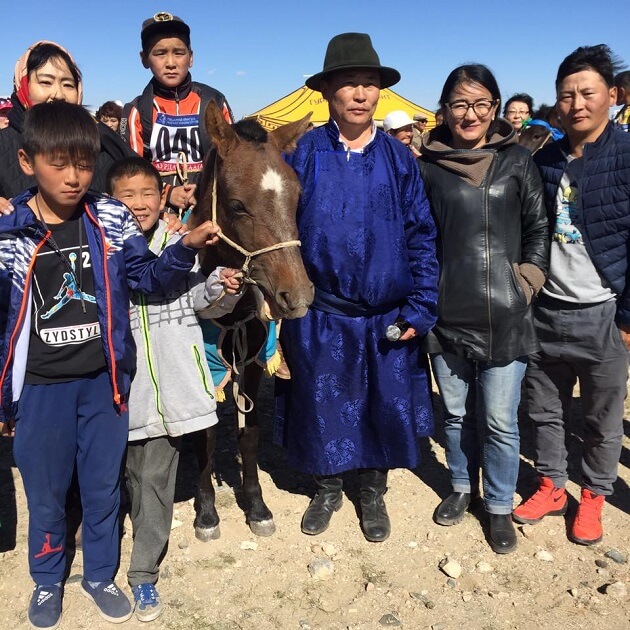
Although I have not had much time to preach there, I have talked with many Mongols and Kalmyks about Jesus. There are now a fellowship of 14 people who have come to faith in Jesus.
When I was in the home of the man I left in charge of the church, a picture of the two of us was taken against the background of the national flag of external Mongolia, because the Mongols in China love the flag of the state of Mongolia. There we are, two Mongols from different parts of the world, united in brotherhood and faith in Jesus Christ!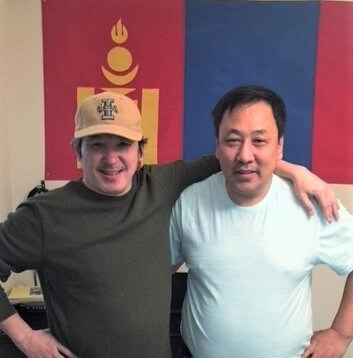
Another group of Kalmyks live in the province of Qinghai. This group of Kalmyks arrived during the time of the intervention. In the 17th century, they conquered Tibet, and became the military ruling class. They have a very good relationship with their fellow Kalmyks in Russia, as they remember that many of their people migrated to the West. So, when I visit them, they happily receive me with warm hospitality. The entire group of about 100,000 people are constantly on the move, roaming with their animals from place to place, from pasture to pasture. Vast, destructive sandstorms coming from the surrounding deserts are not uncommon.
In Qinghai, there are seven Christians who have come to faith through my preaching, but they live isolated, separated from one another by large distances. When circumstances allow, they visit each other’s homes and communicate together. In order to meet these people individually while on the move, I travel widely to different places. This gives me the opportunity to come across many remote villages where I stop and share the Gospel. It is a necessity to have the use of a rental car, which adds to my travel costs. I am looking for partners who will help sponsor my ministry and the cost of reaching the Kalmyk living in these remote parts of the world, that the Great Commission of Matthew 24:14 may be fulfilled! Pastor Sarang Badeev.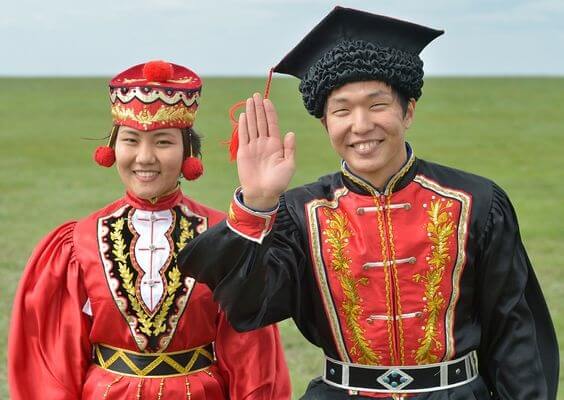
FROM R.K.’S CORNER
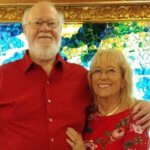 SARANG BADEEV is a native from the Russian Federal Republic of Kalmykia, located between the Black Sea and Caspian Sea — the only Buddhist people in Europe. Sarang, who came to faith during the Soviet era through a the work of a brave American missionary, Andrew Vincent, is pioneering the Gospel in his homeland and among his people who still live in their ancient communities within China and Mongolia.
SARANG BADEEV is a native from the Russian Federal Republic of Kalmykia, located between the Black Sea and Caspian Sea — the only Buddhist people in Europe. Sarang, who came to faith during the Soviet era through a the work of a brave American missionary, Andrew Vincent, is pioneering the Gospel in his homeland and among his people who still live in their ancient communities within China and Mongolia.
The below links to two prior Bridge Reports on Kalmykia gives you the fuller, fascinating story on Andrew, Sarang, and the Kalmyk people – a clear demonstration of God’s love and heart for the ethnos:
https://www.bridgeinternational.org/2015/02/
https://www.bridgeinternational.org/pdf/may2010.pdf
Last year, Sarang visited Kalmyk communities in Mongolia; and mountainous areas of Xinjiang in the north western part of China, where the majority of the Muslim Uighur people live. In an effort to curb ethnic uprisings against their regime, it is believed that the Chinese government is detaining more than one million Uighurs in detention camps. Kalmyks living in the region are also among the minority ethnic groups oppressed by the Chinese. Sarang’s message of God’s love and forgiveness through Jesus is a new, powerful message to his people.
This issue is given to Sarang’s 2018 Travel Letter. Sarang is again ready to travel back to China and Mongolia. If you want to partner with him in reaching the Kalmyks with the Gospel, please mark you gift 8156 Kalmyk Worker. Thank You!
